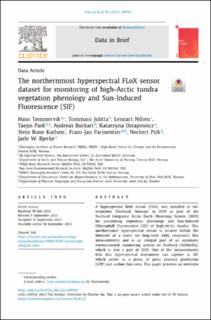| dc.contributor.author | Tømmervik, Hans | |
| dc.contributor.author | Julitta, Tommaso | |
| dc.contributor.author | Nilsen, Lennart | |
| dc.contributor.author | Park, Taejin | |
| dc.contributor.author | Burkart, Andreas | |
| dc.contributor.author | Ostapowicz, Katarzyna Anna | |
| dc.contributor.author | Karlsen, Stein Rune | |
| dc.contributor.author | Parmentier, Frans-Jan W. | |
| dc.contributor.author | Pirk, Norbert | |
| dc.contributor.author | Bjerke, Jarle W. | |
| dc.coverage.spatial | High Arctic, Svalbard | en_US |
| dc.date.accessioned | 2023-10-16T12:40:52Z | |
| dc.date.available | 2023-10-16T12:40:52Z | |
| dc.date.created | 2023-10-13T09:04:12Z | |
| dc.date.issued | 2023 | |
| dc.identifier.issn | 2352-3409 | |
| dc.identifier.uri | https://hdl.handle.net/11250/3096760 | |
| dc.description.abstract | A hyperspectral field sensor (FloX) was installed in Adventdalen (Svalbard, Norway) in 2019 as part of the Svalbard Integrated Arctic Earth Observing System (SIOS) for monitoring vegetation phenology and Sun-Induced Chlorophyll Fluorescence (SIF) of high-Arctic tundra. This northernmost hyperspectral sensor is located within the footprint of a tower for long-term eddy covariance flux measurements and is an integral part of an automatic environmental monitoring system on Svalbard (AsMovEn), which is also a part of SIOS. One of the measurements that this hyperspectral instrument can capture is SIF, which serves as a proxy of gross primary production (GPP) and carbon flux rates. This paper presents an overview of the data collection and processing, and the 4-year (2019–2021) datasets in processed format are available at: https://thredds.met.no/thredds/catalog/arcticdata/infranor/NINA-FLOX/raw/catalog.html associated with https://doi.org/10.21343/ZDM7-JD72 under a CC-BY-4.0 license. Results obtained from the first three years in operation showed interannual variation in SIF and other spectral vegetation indices including MERIS Terrestrial Chlorophyll Index (MTCI), EVI and NDVI. Synergistic uses of the measurements from this northernmost hyperspectral FLoX sensor, in conjunction with other monitoring systems, will advance our understanding of how tundra vegetation responds to changing climate and the resulting implications on carbon and energy balance. Chlorophyll fluorescenceSolar Induced Fluorescence (SIF)ReflectancePhotosynthetic functionMERIS terrestrial chlorophyll index (MTCI)High-Arctic tundra | en_US |
| dc.language.iso | eng | en_US |
| dc.rights | Navngivelse 4.0 Internasjonal | * |
| dc.rights.uri | http://creativecommons.org/licenses/by/4.0/deed.no | * |
| dc.subject | Chlorophyll fluorescence | en_US |
| dc.subject | Solar Induced Fluorescence (SIF) | en_US |
| dc.subject | Reflectance | en_US |
| dc.subject | Photosynthetic function | en_US |
| dc.subject | MERIS terrestrial chlorophyll index (MTCI) | en_US |
| dc.subject | High-Arctic tundra | en_US |
| dc.title | The northernmost hyperspectral FLoX sensor dataset for monitoring of high-Arctic tundra vegetation phenology and Sun-Induced Fluorescence (SIF) | en_US |
| dc.title.alternative | The northernmost hyperspectral FLoX sensor dataset for monitoring of high-Arctic tundra vegetation phenology and Sun-Induced Fluorescence (SIF) | en_US |
| dc.type | Peer reviewed | en_US |
| dc.type | Journal article | en_US |
| dc.description.version | publishedVersion | en_US |
| dc.rights.holder | © 2023 The Authors | en_US |
| dc.subject.nsi | VDP::Zoologiske og botaniske fag: 480 | en_US |
| dc.subject.nsi | VDP::Zoology and botany: 480 | en_US |
| dc.source.volume | 50 | en_US |
| dc.source.journal | Data in Brief | en_US |
| dc.identifier.doi | 10.1016/j.dib.2023.109581 | |
| dc.identifier.cristin | 2184328 | |
| dc.relation.project | Norges forskningsråd: 274711 | en_US |
| dc.relation.project | Andre: Swedish Research Council (2017-05268) | en_US |
| dc.relation.project | Andre: ArcticHubs (869580) | en_US |
| dc.relation.project | Norges forskningsråd: 287402 | en_US |
| dc.relation.project | Norges forskningsråd: 269927 | en_US |
| dc.relation.project | EU/EU CHARTER (869471) | en_US |
| dc.source.articlenumber | 109581 | en_US |
| cristin.ispublished | true | |
| cristin.fulltext | original | |
| cristin.qualitycode | 1 | |

